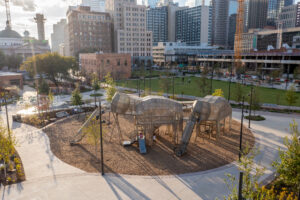This is the second of three blogs in our Monumental Mammoths series about the Harwood Park playground, which features giant sculptural play elements and educational information related to Columbian mammoths, which roamed North Texas about 100,000 years ago. We recently interviewed Dr. Ron Tykoski, the Director of Paleontology and Curator of Vertebrate Paleontology at the Perot Museum of Nature and Science in Dallas, about the mammoths and their way of life. This conversation has been edited for clarity. Learn more about the playground features here, and about Harwood Park and all its amenities. Harwood Park – and the playground – is scheduled to open in spring 2023.
Previously: Learn what Downtown Dallas and North Texas was like 100,000 years ago, and how the Columbian mammoths migrated to the area. Learn more.
How large were Columbian mammoths? The playscape will be one of several focal points throughout Harwood Park, but if a mammoth walked into Downtown Dallas today, what would its size equate to?
Much like modern elephants, males (bulls) were often much larger than females (cows). Whereas an average bull African elephant can measure around 10 to 11 feet at the shoulder and weigh around 6.5 tons, an average bull Columbian mammoth would be more like 12 to 13 feet at the shoulder and weigh around 10 tons.
However, like with modern elephants, there were larger-than-normal or exceptionally large individuals that were more like 14 to 15 feet at the shoulder and could have weighed closer to 12-15 tons!
Some relatable comparisons in Downtown Dallas include:
- A DART light-rail car is 13 feet tall.
- An extra-large bull Columbian mammoth would be just about half the height of the Giant Eyeball sculpture between Main Street and Elm Street.
- An average-sized bull Columbian mammoth would be able to leave Dealey Plaza westbound on Main Street by just barely slipping under the rail overpass with inches to spare. However, an extra-large bull mammoth would bump its forehead and shoulders on the underside of the overpass, and would have to find a different path out of the plaza.
The playscape will feature two mammoths, which indicate a herd mentality for the species. Can you tell us about how the mammoths traveled (were they pack animals?) and their family dynamic?
Modern elephants offer us the best model for reconstructing mammoth herd dynamics and behaviors. In all likelihood, they formed herds composed mainly of a few related adult females, and their offspring, including immature males. The oldest female would likely be the matriarch, the female leader of the family group. As young males matured, they would have been forced out of the herd to fare on their own or in small groups of similar bachelor males living on the periphery of established female-dominated herds, avoiding larger mature bulls and keeping an eye open for potential mates.
The multiple mammoth skeletons found at the Waco Mammoth Site National Monument offer evidence of such a herd. The skeletons there include individuals of different sizes and ages that apparently died together in a narrow, steep-walled section of a river channel.
Let’s jump back in our time machine and travel back 100,000 years to see Dallas and North Texas. What other animals roamed the North Texas landscape 100,000 years ago?
BISON: Outnumbering mammoths and mastodons are herds of bison and horses. While those don’t sound very exotic at first, think again. The bison that inhabited our region 100,000 years ago put our modern species (Bison bison) to shame. The Steppe bison (Bison priscus) arrived in North America from Asia between 300,000 and 130,000 years ago, but quickly spread southward and gave rise to a new, uniquely North American giant species, Bison latifrons. This brute was roughly double the size of today’s species and sported massive horns that could span upwards of seven feet across! The descendants of this line eventually downsized into successively smaller and smaller-horned species (Bison antiquus) and later our much smaller modern North American bison. Fossils of all three of these native North American species are in Texas, and people find partial skulls, horn cores, other bones, and teeth of them in the Dallas area.
HORSES: When you look at the horses, you notice something a bit odd about them. Sure, they’re obviously horses, but they also appear divided into two body styles. The larger body style looks similar to wild equine horses you’re familiar with today from Asia and Africa. Big bodied, with stout legs and hooves, they roam and graze the grassy patches as far as the eye can see. Mixed in among them though are smaller horses, with slender legs, narrower hoofs, and generally slimmer builds. Those slender-limbed horses are part of a lineage that arose in North America millions of years before modern equine horses appeared. The reason they look a little odd to you is because that entire line went extinct around 10,000 years ago, leaving no living members. Yet, at 100,000 years ago they’re living side by side with one or more species of large-bodied horses right here in north Texas.
PRONGHORNS: You begin looking around and search more closely, and you notice other odd species. You see animals that remind you of the pronghorn antelope you find in west Texas today. You’re actually pretty close in your assessment. These were close relatives of the modern pronghorn and look a lot like them – except instead of two black, curled horns atop their head these 100,000-year-old animals (Tetrameryx shuleri) sport four horns pointing up from their heads, with two shorter horns in the front and two much longer ones behind.
GIANT BEAVER: You wander down closer to the tree-lined banks of a large creek and catch a glimpse of a huge, giant beaver (Castoroides), a rodent nearly the size of a modern black bear, with massive gnawing incisors several inches long and each thicker than a person’s thumb.
GIANT ARMADILLO: Then you spot what at first you think is a familiar nine-banded armadillo rustling in the brush – until it steps out in full view. Instead of the cute little ‘dillo you expect, it’s a 5-foot long, thigh-high, 200-300 pound, supersized armadillo-like animal (Holmesina septentrionalis). It’s covered in a mosaic of bony plates like a normal armadillo, and has a few rows of flexible bands across the midsection of the armored covering. The head is much thicker and wider though, and instead of rummaging along the ground looking for grubs, worms, and bugs, it munches on low-growing leaves.
GIANT GROUND SLOTH: As if the super-sized armadillo didn’t look weird enough, another movement across the creek catches your eye. A nearly cow-sized, shaggy-haired creature is slowly walking down to the water for a drink. The long front legs bear huge, curved claws nearly a foot long on each hand. It almost knuckle-walks on the sides of the huge claws as it meanders to the water and starts drinking. The back legs are short, it’s hard to see a distinct tail in all that hair, and you have a flashback to a much smaller, cuter animal you’ve seen hanging out in tropical trees at the Dallas World Aquarium. You make the mental connection and realize this weirdo is a giant ground sloth.
DIRE WOLVES: You leave the creek to look around the patchy grasslands again, and notice movement along the edge of some trees. There is a group of what look like shorthaired alpacas or llamas nibbling on the branches. It turns out North America was home to several species of camels over millions of years, and the ones you see are among some of the last to live here. What really catches your eye is a pack of dog-like animals that are closing in on the small camels. At first, you might think maybe they’re coyotes, or maybe even gray wolves like those that used to inhabit much of the continent prior to their near-extermination in the early 20th century. Look closer, and you realize these are aptly named dire wolves – no, not the giant beasts of Game of Thrones fiction, but real flesh and bone-crunching dogs. Recent DNA studies found the dire wolves (Aeoncyon dirus) weren’t close relatives of gray wolves. Instead, they were the last members of a much older North American lineage of dogs. Regardless, they are frightening to see. The average dire wolf was the size of the largest modern gray wolf, with a broader skull and muzzle, larger jaw muscles, and stronger teeth adapted to break the bones of the large plant-eating mammals of the time.
SABER-TOOTHED CAT: If the pack of dire wolves wasn’t worrisome enough, you spot a big cat stealthily slipping through the brush, approaching a group of horses. As large as a lion, but more heavily muscled in the shoulders and arms, you see a pair of long, yellow-white teeth protruding down past its lips and beyond the cat’s squared-off chin. This is one of the icons of the Ice Age, a saber-toothed cat (Smilodon fatalis). The long, curved upper canines of saber-toothed cats evolved to help pierce and slash through the thick hide of the necks and bellies of the large herbivores it preyed upon, causing massive blood loss leading to eventual system shock and death.
GIANT SHORT-FACED BEAR: Suddenly, you notice the herds of horses and giant bison stop their feeding and warily watch another huge, hairy beast strolling in your direction. The beast is six feet tall at the shoulder, with a short muzzle on a massive, broad head, and is bigger than the largest modern Kodiak brown bear or polar bear. You realize with a chill that you’re looking at a giant short-faced bear (Arctodus simus) heading toward you. The long muscular legs allowed it to cover ground more quickly than a modern bear, and it can use them to snap the neck of a giant bison as easily as a modern grizzly bear can kill an elk. It dawns on you that the massive bear probably caught wind of your unfamiliar scent, and is coming your way to investigate whether you might make a tasty, easy meal. You quickly hop back in your time machine before becoming the next item on the menu, and return to the mundane, much less impressive fauna of the early 21st century.
Coming up on Tuesday, September 14: Learn about the importance of hands-on education, from parks to museums, and how the North Texas environment continued to evolve after the Columbian mammoths went extinct. Learn more.
About Dr. Ron Tykoski
Dr. Ron Tykoski is the Director of Paleontology and Curator of Vertebrate Paleontology at the Perot Museum of Nature and Science in Dallas. Dr. Tykoski holds a Ph.D. in Geological Sciences from The University of Texas at Austin; a Master of Science in Geological Sciences from The University of Texas at Austin; and a Bachelor of Science in Geological Sciences from The University of Michigan – Ann Arbor. After finishing his Ph.D., he started at the Dallas Museum of Natural History as its Fossil Preparator, and continued there as the museum evolved into the current Perot Museum of Nature and Science. He’s worked on and even helped name various predatory dinosaurs, plant-eating dinosaurs, fossil crocodilians, and fossil birds over the years. In 2014, he oversaw the collection of a nearly complete female Columbian mammoth skeleton near the town of Italy, Texas, in Ellis County. He supervised the preparation of the specimen, and assisted with its installation on exhibit in the Perot Museum in 2015. The 35,000-year-old skeleton is displayed just outside the museum’s third-floor elevators.





